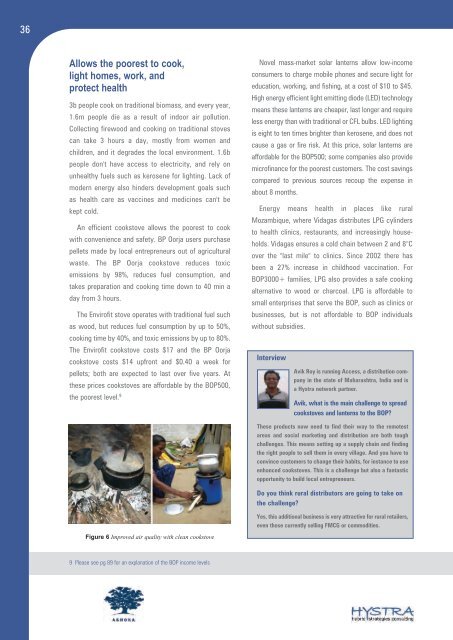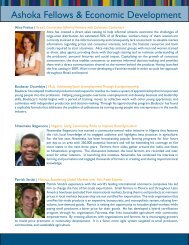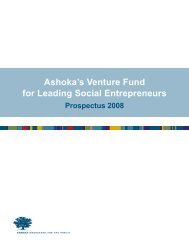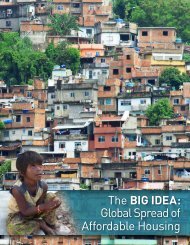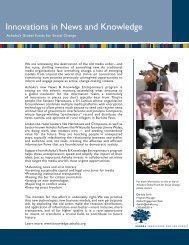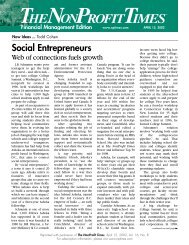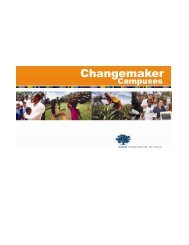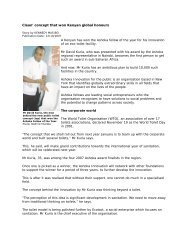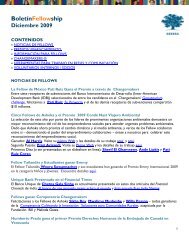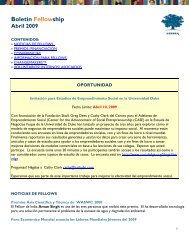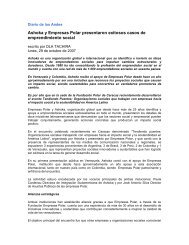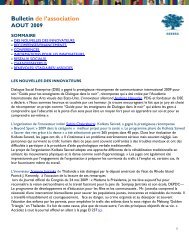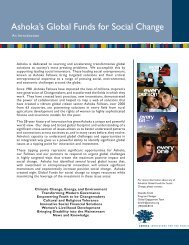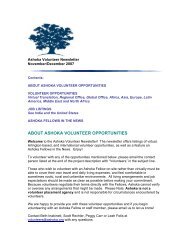Access to Energy for the Base of the - Ashoka
Access to Energy for the Base of the - Ashoka
Access to Energy for the Base of the - Ashoka
Create successful ePaper yourself
Turn your PDF publications into a flip-book with our unique Google optimized e-Paper software.
36<br />
Allows <strong>the</strong> poorest <strong>to</strong> cook,<br />
light homes, work, and<br />
protect health<br />
3b people cook on traditional biomass, and every year,<br />
1.6m people die as a result <strong>of</strong> indoor air pollution.<br />
Collecting firewood and cooking on traditional s<strong>to</strong>ves<br />
can take 3 hours a day, mostly from women and<br />
children, and it degrades <strong>the</strong> local environment. 1.6b<br />
people don't have access <strong>to</strong> electricity, and rely on<br />
unhealthy fuels such as kerosene <strong>for</strong> lighting. Lack <strong>of</strong><br />
modern energy also hinders development goals such<br />
as health care as vaccines and medicines can't be<br />
kept cold.<br />
An efficient cooks<strong>to</strong>ve allows <strong>the</strong> poorest <strong>to</strong> cook<br />
with convenience and safety. BP Oorja users purchase<br />
pellets made by local entrepreneurs out <strong>of</strong> agricultural<br />
waste. The BP Oorja cooks<strong>to</strong>ve reduces <strong>to</strong>xic<br />
emissions by 98%, reduces fuel consumption, and<br />
takes preparation and cooking time down <strong>to</strong> 40 min a<br />
day from 3 hours.<br />
The Envir<strong>of</strong>it s<strong>to</strong>ve operates with traditional fuel such<br />
as wood, but reduces fuel consumption by up <strong>to</strong> 50%,<br />
cooking time by 40%, and <strong>to</strong>xic emissions by up <strong>to</strong> 80%.<br />
The Envir<strong>of</strong>it cooks<strong>to</strong>ve costs $17 and <strong>the</strong> BP Oorja<br />
cooks<strong>to</strong>ve costs $14 upfront and $0.40 a week <strong>for</strong><br />
pellets; both are expected <strong>to</strong> last over five years. At<br />
<strong>the</strong>se prices cooks<strong>to</strong>ves are af<strong>for</strong>dable by <strong>the</strong> BOP500,<br />
<strong>the</strong> poorest level. 9<br />
Figure 6 Improved air quality with clean cooks<strong>to</strong>ve<br />
9 Please see pg 89 <strong>for</strong> an explanation <strong>of</strong> <strong>the</strong> BOP income levels<br />
Novel mass-market solar lanterns allow low-income<br />
consumers <strong>to</strong> charge mobile phones and secure light <strong>for</strong><br />
education, working, and fishing, at a cost <strong>of</strong> $10 <strong>to</strong> $45.<br />
High energy efficient light emitting diode (LED) technology<br />
means <strong>the</strong>se lanterns are cheaper, last longer and require<br />
less energy than with traditional or CFL bulbs. LED lighting<br />
is eight <strong>to</strong> ten times brighter than kerosene, and does not<br />
cause a gas or fire risk. At this price, solar lanterns are<br />
af<strong>for</strong>dable <strong>for</strong> <strong>the</strong> BOP500; some companies also provide<br />
micr<strong>of</strong>inance <strong>for</strong> <strong>the</strong> poorest cus<strong>to</strong>mers. The cost savings<br />
compared <strong>to</strong> previous sources recoup <strong>the</strong> expense in<br />
about 8 months.<br />
<strong>Energy</strong> means health in places like rural<br />
Mozambique, where Vidagas distributes LPG cylinders<br />
<strong>to</strong> health clinics, restaurants, and increasingly households.<br />
Vidagas ensures a cold chain between 2 and 8°C<br />
over <strong>the</strong> "last mile" <strong>to</strong> clinics. Since 2002 <strong>the</strong>re has<br />
been a 27% increase in childhood vaccination. For<br />
BOP3000+ families, LPG also provides a safe cooking<br />
alternative <strong>to</strong> wood or charcoal. LPG is af<strong>for</strong>dable <strong>to</strong><br />
small enterprises that serve <strong>the</strong> BOP, such as clinics or<br />
businesses, but is not af<strong>for</strong>dable <strong>to</strong> BOP individuals<br />
without subsidies.<br />
Interview<br />
Avik Roy is running <strong>Access</strong>, a distribution company<br />
in <strong>the</strong> state <strong>of</strong> Maharashtra, India and is<br />
a Hystra network partner.<br />
Avik, what is <strong>the</strong> main challenge <strong>to</strong> spread<br />
cooks<strong>to</strong>ves and lanterns <strong>to</strong> <strong>the</strong> BOP?<br />
These products now need <strong>to</strong> find <strong>the</strong>ir way <strong>to</strong> <strong>the</strong> remotest<br />
areas and social marketing and distribution are both <strong>to</strong>ugh<br />
challenges. This means setting up a supply chain and finding<br />
<strong>the</strong> right people <strong>to</strong> sell <strong>the</strong>m in every village. And you have <strong>to</strong><br />
convince cus<strong>to</strong>mers <strong>to</strong> change <strong>the</strong>ir habits, <strong>for</strong> instance <strong>to</strong> use<br />
enhanced cooks<strong>to</strong>ves. This is a challenge but also a fantastic<br />
opportunity <strong>to</strong> build local entrepreneurs.<br />
Do you think rural distribu<strong>to</strong>rs are going <strong>to</strong> take on<br />
<strong>the</strong> challenge?<br />
Yes, this additional business is very attractive <strong>for</strong> rural retailers,<br />
even those currently selling FMCG or commodities.


